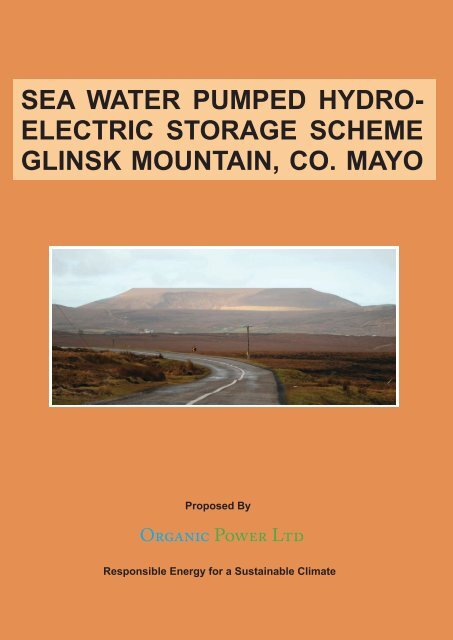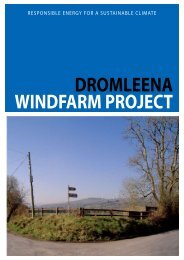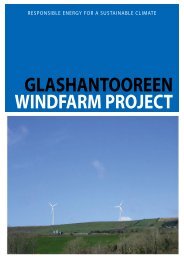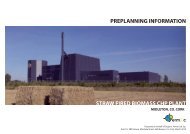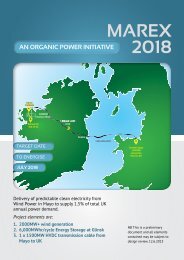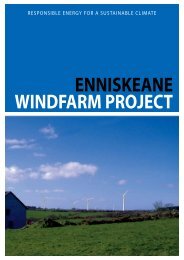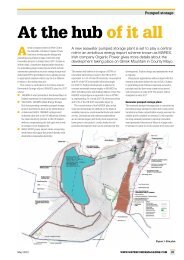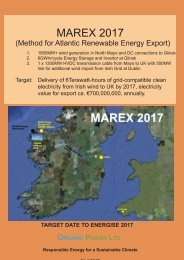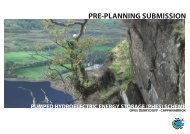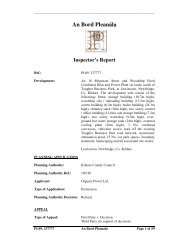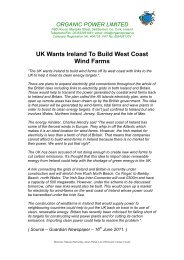OP18 Brochure 20 March 2010 Pinky.indd - Organic Power
OP18 Brochure 20 March 2010 Pinky.indd - Organic Power
OP18 Brochure 20 March 2010 Pinky.indd - Organic Power
Create successful ePaper yourself
Turn your PDF publications into a flip-book with our unique Google optimized e-Paper software.
SEA WATER PUMPED HYDRO-<br />
ELECTRIC STORAGE SCHEME<br />
GLINSK MOUNTAIN, CO. MAYO<br />
Proposed By<br />
<strong>Organic</strong> <strong>Power</strong> Ltd<br />
Responsible Energy for a Sustainable Climate
PROPOSED SEA WATER PHES SCHEME<br />
Where is the Proposed Sea<br />
Water PHES Scheme Located?<br />
Glinsk, Co. Mayo has been selected<br />
for this project because of its almost<br />
unique qualities as a high, fl attopped,<br />
mountain beside the sea,<br />
composed of very hard, impermeable,<br />
and immensely stable schist<br />
rock.<br />
What is a Sea Water Pumped<br />
Hydroelectric Energy Storage<br />
Scheme?<br />
A pumped hydroelectric storage<br />
scheme (PHES) is a device for<br />
storing energy. It is used to accept<br />
excess energy from the electricity<br />
grid when production is high relative<br />
to demand, and deliver energy<br />
back to the grid when demand is<br />
high and production is low. It is<br />
an established technology worldwide,<br />
with hundreds of schemes<br />
such as Turlough Hill in Wicklow, in<br />
successful and safe operation. A<br />
similar type sea water PHES has<br />
been functioning successfully in a<br />
National Park in Japan since 1999.<br />
How will the Proposed<br />
Sea Water PHES at Glinsk<br />
work?<br />
The Glinsk project will use the<br />
sea as the lower reservoir and<br />
will work as follows: The facility<br />
will accept power, primarily excess<br />
wind power, during off peak<br />
night time hours or when generation<br />
exceeds demand and use<br />
it to pump sea water to a reservoir<br />
on the top of Glinsk Mountain.<br />
The stored energy will be<br />
returned to the grid through turbines<br />
for use during peak times<br />
in the morning and evening, or<br />
generation emergencies.<br />
Location Seawater PHES at Okinawa, Japan PHES at Turlough Hill, Co. Wicklow<br />
<strong>Organic</strong> <strong>Power</strong> Ltd
BENEFITS OF THE PHES SCHEME<br />
• It will be able to accept enormous quantities<br />
of clean but unpredictable energy<br />
from local windfarms and ocean energy<br />
projects, and transform it into a high quality<br />
predictable green electricity product by<br />
storing it for use when needed.<br />
• Over a short time frame it will potentially<br />
provide large amounts of green electricity<br />
to the Irish ecomony.<br />
• It will signifi cantly reduce the national<br />
need for imported fossil fuels that are<br />
required to keep gas, coal and oil fi red<br />
power stations running.<br />
• Large energy consumers will be able to<br />
benefi t from this reliable green energy<br />
source to reduce their carbon footprint.<br />
• It will be able to accept up to one third<br />
of the projected surplus night time wind<br />
power that will be produced in Ireland<br />
when the national target of 5,000MW of<br />
wind turbines is achieved under Government<br />
policy by <strong>20</strong><strong>20</strong>.<br />
• It should signifi cantly expedite the delivery<br />
of the wind energy target by providing<br />
a high voltage transmission grid connection<br />
to the North West, allowing one fi fth<br />
of the wind energy target for the country<br />
as a whole, which is already permitted in<br />
the area, to be built.<br />
• The project will also be a tourist attraction<br />
to the area with an on site visitors centre.<br />
Input electricity will be preferentially sourced from grid connected wind and wave energy<br />
projects. The process will transform unpredictable and variable wind and wave power to<br />
reliable, dispatchable power delivered to the grid.<br />
<strong>Organic</strong> <strong>Power</strong> Ltd
OUTLINE OF THE PROJECT<br />
The Site<br />
The site of the project faces the Atlantic<br />
Ocean and the upper reservoir is located<br />
on the plateau of Glinsk mountain,<br />
288.75 metres above sea level and about<br />
700m from the coast. To preserve the<br />
landscape in the area, the penstock and<br />
powerhouse will be laid underground.<br />
Glinsk Mountain<br />
The Upper Reservoir<br />
The upper reservoir will be 27m deep with<br />
a surface area of 315,258m 2 . It has an<br />
effective storage capacity of 6.4million<br />
m 3 . The shape and location of the upper<br />
reservoir was determined based on topography<br />
and a minimum volume of earth<br />
works with an optimum balance between<br />
excavation and embankment volumes.<br />
Example upper reservoir<br />
The <strong>Power</strong> House<br />
The powerhouse will be located approx.<br />
35 - 50m below sea level, adjacent to a<br />
protected sea chasm at the north eastern<br />
part of the site and will consist of a cavern<br />
containing the 2 number 240MW pump<br />
turbines. This cavern will be accessed<br />
by a vertical 150m deep access shaft<br />
from the surface of the ground above.<br />
Site layout at Glinsk, Co. Mayo<br />
Intake Structure<br />
The cavern will be connected to the<br />
sea by a 1<strong>20</strong>m long intake structure<br />
located below sea level in the east<br />
facing cliff of the sea chasm. The<br />
water in the chasm will come from<br />
the open Atlantic through a tetrapod<br />
mound wave attenuation structure located<br />
at the mouth of the sea chasm.<br />
The sluiced water intake structure<br />
will be constructed below sea level<br />
from re-inforced concrete to allow<br />
water to be extracted and pumped to<br />
the reservoirs. The intake structures<br />
tail race pipe will be constructed to a<br />
depth of approx. 35 - 50m below sea<br />
level to provide suffi cient back pressure<br />
on the pump-turbine to eliminate<br />
cavitation. Appropriate sluice controls<br />
and trash racks will be included.<br />
Example of a power house and turbine<br />
Example of an intake structure<br />
Wave and Flow Attenuation<br />
Structure<br />
A revetment of tetrapods (precast<br />
concrete blocks) will be laid at the<br />
mouth of the inlet, with 2 main functions:<br />
a) to minimise wave erosion<br />
and reduce water level fl uctuation<br />
during pumping and b) to disipate the<br />
energy of the exiting water post generation<br />
and protect marine habitat.<br />
Example of tetrapod structures<br />
<strong>Organic</strong> <strong>Power</strong> Ltd
PROJECT SPECIFICATIONS<br />
Description Unit Data<br />
Upper Reservoir<br />
High water level m 301.5<br />
Low water level m 276<br />
Available drawdown m 25.5<br />
Water surface area m 2 315258<br />
Gross storage capacity m 3 6,400,000<br />
Type - Embankment<br />
dam (rubber<br />
sheet and asphaltic<br />
lining)<br />
Height m 27<br />
Crest length m 2560<br />
Embankment volume m 3 2,644,000<br />
Waterways<br />
Waterway intake - Morning Glory<br />
Type<br />
Penstock (Inside dia. x length) m x m 5.85 x 850<br />
Tailrace tunnel<br />
(Inside dia. x length) m x m 6.5 x 100<br />
<strong>Power</strong> generation<br />
Normal headwater level m 300<br />
Normal tailwater level m 0<br />
Normal effective head m 280<br />
Maximum discharge m 3 /s 211<br />
Maximum output MW 440<br />
Transmission line<br />
Voltage kV 2<strong>20</strong><br />
Length km approx. <strong>20</strong><br />
<strong>Organic</strong> <strong>Power</strong> Ltd
POWER GENERATION<br />
Pump / Turbine and Motor / Generator<br />
Once operational the PHES project<br />
will supply electrical power using<br />
two identical pump/turbines. A total<br />
of 6,400,000m 3 of sea water will<br />
be pumped to an average elevation<br />
of 288.7m above sea level, using<br />
480MW of electric power sourced<br />
from the grid during off peak hours of<br />
electricity demand. When released,<br />
the water from the reservoir will generate<br />
electrical power at 440MW from<br />
the two turbines. This power will be<br />
delivered back to the grid during peak<br />
demand hours.<br />
The PHES scheme will deliver power<br />
9.75 hours per day, corresponding to<br />
peak demand from 0600 - 10.30 and<br />
16.15 - 19.30. The scheme will accept<br />
energy off peak for 4 up to <strong>20</strong> hours<br />
per day depending on the available<br />
wind energy.<br />
Materials for the pump-turbine runner<br />
and the guide vanes will be made<br />
from austenite stainless steel which<br />
has anticavitation, antiwear and anticorrosive<br />
characteristics.<br />
For high effi ciency power generation<br />
and pumping, a variable speed<br />
pumped storage power generation<br />
system will be used, based on a gate<br />
turn off thyristor converter - inverter<br />
AC excitation system.<br />
Conventional pumped storage power<br />
generation systems, enable the automatic<br />
frequency control operation<br />
only during generating operation by<br />
adjusting guide vanes. However, the<br />
variable speed pumped storage power<br />
generation system enables the automatic<br />
frequency control operation<br />
during pumping operation as well as<br />
generating operation by adjusting<br />
the resolving speed of the unit.<br />
Therefore, the variable speed system<br />
reduces the impacts on the<br />
power system by minimising input<br />
power operation at the beginning of<br />
the pumping operation.<br />
The variable speed system also<br />
enables higher efficiency operation<br />
during generation than the conventional<br />
system, because the revolving<br />
speed is controlled at a high effi<br />
cency point corresponding to the<br />
nominated net head and output.<br />
Pump Turbine Schematic Drawing (Indicative Only)<br />
Example of a Pump Turbine<br />
<strong>Organic</strong> <strong>Power</strong> Ltd
SAFETY<br />
Mountain Stability<br />
Geophysical surveying will be<br />
carried out as part of the Environmental<br />
Impact Statement and the<br />
planning process, to confi rm the<br />
stable bedrock characteristics of<br />
Glinsk Mountain. The reservoir<br />
will be a gravity retaining structure<br />
constructed with rock and<br />
depositional soils from within the<br />
site.<br />
Cliff face at Glinsk<br />
Peat Storage<br />
Peat will need to be removed from<br />
the top of Glinsk mountain during<br />
the construction of the upper reservoir.<br />
It will be placed in a stable<br />
storage area at the bottom of the<br />
mountain. A Peat Landslide Risk<br />
Assessment will be carried out as<br />
part of the Environmental Impact<br />
Statement and will be monitored<br />
closely at all stages of construction<br />
and operation.<br />
Sealing the Reservoir<br />
An ethylene propylene diene monomer<br />
(EPDM) rubber sheet will be used<br />
for the lining of the inner dam slopes<br />
of the upper reservoir, and asphaltic<br />
liner used to seal the reservoir fl oor,<br />
in order to prevent water leaking from<br />
the reservoir into the surrounding environment.<br />
An EPDM has excellent<br />
material properties and weather resistance<br />
characteristics.<br />
Sea Water Detection System<br />
If damage to the sheet occurs, seawater<br />
leakage will be detected by a<br />
Leakage Monitoring and Detection<br />
System. Underneath the sealing<br />
systems of the reservoir a drainage<br />
system will be put in place in order to<br />
channel possible leakage water. This<br />
system will enable immediate action<br />
in case of the occurence and/or in<br />
case of changes in the level of leakage<br />
water. It will also prevent sea water<br />
from leaking into the neighbouring<br />
environment. Furthermore, a fi bre<br />
optic leakage detection and localisation<br />
system will be installed to pinpoint<br />
possible leaks at critical points in the<br />
structure. Also, as the rubber sheet is<br />
the top layer of the lining structure, it<br />
can be repaired easily.<br />
Noise<br />
Noise sensitive locations will be<br />
identifi ed and the Environmental<br />
protection Agency (EPA) Guidelines<br />
for noise limits will be followed.<br />
During construction it is<br />
expected that there will be some<br />
noise from plant and equipment<br />
on site. All noise limits will be adhered<br />
to at the nearest residence<br />
and noise sensitive locations,<br />
therefore there will be no signifi<br />
cant noise impact as a consequence<br />
of the development. During<br />
operation the only signifi cant<br />
source of noise will be from the<br />
pump turbines. However, as these<br />
are located deep underground<br />
they will not be audible to receptors<br />
outside of the site.<br />
Construction Traffic<br />
The project will use on site materials<br />
as much as possible and it is expected<br />
that there will be no rock or soil<br />
imported or exported from the site.<br />
The access roads and reservoir will<br />
be designed to balance the rock cut<br />
and fi ll volumes. This will signifi cantly<br />
reduce the amount of construction<br />
traffi c to and from the site.<br />
Peat on Glinsk Mountain<br />
Schematic of the rubber lining system for the upper reservoir.<br />
<strong>Organic</strong> <strong>Power</strong> Ltd
ENVIRONMENTAL CONSERVATION<br />
How can we limit the impact of<br />
the development on the Natural<br />
Environment?<br />
In designing and building the proposed<br />
pumped hydroelectric scheme,<br />
we will adopt the following basic policies<br />
in pursuit of harmony between<br />
development and preservation of the<br />
environment.<br />
• The extent of alteration of the site<br />
will be minimised to ease the impact<br />
on the natural environment.<br />
• Damaged environment will be restored<br />
where possible to assist<br />
habitat diversifi cation.<br />
Reduction in discharge velocity<br />
To mitigate the impact of sea water<br />
discharge on marine life from power<br />
generation, a breakwater of precast<br />
concrete blocks will be installed at the<br />
mouth of the sea chasm, and thereby<br />
the sea velocity at the time of power<br />
generation will be reduced signifi cantly.<br />
Conservation of small animals<br />
(From best practice at Yanbaru<br />
SWPHES, Japan)<br />
Fences (30cm in height, made of<br />
polyethylene) will be installed around<br />
the construction area so that small<br />
animals can not enter the construction<br />
area, thus protecting them from<br />
accidents involving construction vehicles.<br />
Slope side ditches will also be installed.<br />
This structure enables small<br />
animals to exit by way of the slope<br />
in the direction from which they entered,<br />
even when they fall into the<br />
side ditches.<br />
• As part of the planning process an<br />
Environmental Impact Statement<br />
will be prepared and will include<br />
exhaustive studies to assess the<br />
impact of the project on the local<br />
fl ora and fauna, birds, marine life<br />
and waterways as well as noise<br />
assessments both during construction<br />
and operational phases.<br />
It will also detail mitigation measures<br />
that will be followed to minimise<br />
the impacts identifi ed.<br />
The following measures will be implemented<br />
to conserve the land and sea,<br />
and the fl ora and fauna occupying<br />
those areas:<br />
Proposed breakwater at Glinsk<br />
Treatment of muddy water<br />
For the purpose of preventing damage<br />
by muddy water as a result of earthworks,<br />
all muddy water generated at<br />
the construction site will be stored in<br />
sedimentation ponds and treated before<br />
discharging into natural streams.<br />
Slope side ditch at Yanbaru<br />
Planting<br />
The reservoir embankments and surrounding<br />
areas will be re planted with<br />
natural grasses and plants in keeping<br />
with the local fl ora. This will also prevent<br />
soil erosion.<br />
Existing fl ora on Glinsk Mountain<br />
<strong>Organic</strong> <strong>Power</strong> Ltd
ENVIRONMENTAL CONSERVATION<br />
Conservation of Birds<br />
The following Annex 1 Bird species: Merlin,<br />
Chough, Peregrine and Golden Plover and<br />
the Red Data book species Twite are present<br />
on the northwest Mayo coastal area,<br />
within which the site is located. In order<br />
to help the conservation of these bird species<br />
the following measures will be implemented:<br />
• Stock proof fencing will be erected on<br />
the cliff edge to allow cliff vegetation<br />
to grow properly and provide excluded<br />
nesting areas for sea birds.<br />
• Wet grassland will be created in peat<br />
storage areas to encourage nesting<br />
sites for the Golden Plover.<br />
• Tussock heather growth will be encouraged<br />
to expand habitat for the Twite,<br />
and to facilitate raptor foraging.<br />
Merlin<br />
Chough<br />
Golden Plover<br />
Twite<br />
Peregrine<br />
<strong>Organic</strong> <strong>Power</strong> Ltd
PHOTOMONTAGES<br />
Existing View<br />
View after Construction<br />
View from Céide Fields<br />
Existing View<br />
View after Construction<br />
View from R314 Ballycastle to Belderg Road<br />
Existing View<br />
View after Construction<br />
11<br />
View from Owenanirragh, South west of Glinsk Mountain<br />
11<br />
10<br />
<strong>Organic</strong> <strong>Power</strong> Ltd
PHOTOMONTAGES<br />
Existing View<br />
View after Construction<br />
View from R313 at the Broadhaven Bay Hotel<br />
Existing View<br />
View after Construction<br />
View at Chasm for Inlet Structure<br />
<strong>Organic</strong> <strong>Power</strong> Ltd<br />
11
<strong>Organic</strong> <strong>Power</strong> Ltd Team Surveying on Glinsk Mountain<br />
<strong>Organic</strong> <strong>Power</strong> Ltd<br />
FBD House, Mardyke Street, Skibbereen,<br />
County Cork, Ireland<br />
Tel: +353 (0)28 51951<br />
Web : www.organicpower.ie<br />
Printed <strong>March</strong> <strong>20</strong>10


